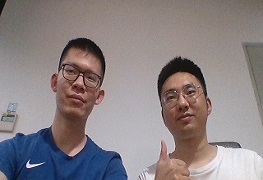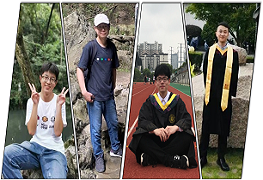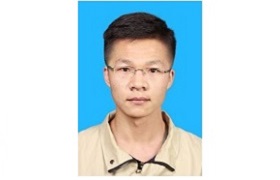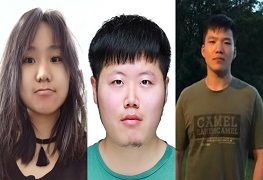


Winning Team: MagiXterial
Team Leader: Yifeng Tang
Team members: Qingchuan Yang, Han Xu, Zuochao Zhao, Huishuang Tan
Summary:
-Compared traditional ML methods with neural networks on predicting alloy properties from compositions
-Proposed a new stacking model which uses GBDT trees as featurizer followed by a neural network regressor
-Compared the performance of three methods on predicting alloy compositions from properties: Direct Backward NN Modelling,
Iterative Searching and Optimization and Generative Model

Winning Team: AI.Rex
Team Leader: Yifeng Tang
Team members: Huishuang Tan, Hanzhang Liu, Jiayu Qin, Wanxiang Shen, Long Qian
Summary:
In chemical synthesis planning, retrosynthsis analysis tools can readily provide numerous synthetic paths,
but that is beyond the capacity of experimental validation. Hence, evaluating the reaction feasibility accuractely
and efficiently is vital in reducing the number of proposed paths and only retaining those have higher chance of
success in wet lab. We successfully built models based on reaction SMILES or reaction graph, and achieved reasonably
high test accuracy in both approches (>90%). We managed to integrate reactivity-related Quantum Mechanics descriptors
into the feasibility prediction model and boosted the mode performance.

Winning Team: OMX
Team Leader: Wanxiang Shen
Team members: Wanxiang Shen
Summary:
The original intention was to establish an interpretable xAI-based omics machine learning model and
algorithm flow for disease prediction, diagnosis and identification of key markers.
The customized multi-channel AggMapNet outperformed state-of-the-art machine learning models, and
the interpretable module of AggMapNet identified key metabolites or proteins for Covid-19 tests, and the predictions of
disease severity were highly consistent with the biomarkers or biological mechanisms reported in the literature.

Winning Team: Alpha-Spec
Team Leader: Jian Song
Team members: Liqi Yan
Summary:
Deep learning technology was used to identify whether the secondary spectrum collected by the mass
spectrometer were signal or noise. Alpha-Spec used an advanced deep learning module, Transformer,
and the model was trained for 7 rounds.
The deep learning model of Alpha-Spec achieved the recognition of spectral quality based solely on
spectra (acc: ~70%). The spectra quality scoring system of the Alpha-Spec can improve DDA identification
(PSM: ~3.3%).

Winning Team: TQL
Team Leader: Zheng Cao
Team members: Tiantao Liu
Summary:
The team proposed a synthesis evaluation system to analyze the synthetic accessibility and
identify the possible side products.

Winning Team: CRITICAL
Team Leader: Ke Liu
Team members: Shangde Gao, Kaifan Yang, Yichao Fu
Summary:
The team built a model comprised of input layer, embedding layer, aggregation layer,
attention layer and Set2Set layer to predict the stiffness tensor of materials.

Winning Team: Aimat
Team Leader: Xiangyu Zhang
Team members: Xiangyu Zhang
Summary:
The team Adapted the CGNN and GeoCGNN models to predict stiffness tensors of materials from
their crystal structure

Winning Team: MagiXterial
Team Leader: Yifeng Tang
Team members: Qingchuan Yang, Han Xu, Zuochao Zhao, Huishuang Tan
Summary:
Proposed a new stacking model which uses GBDT trees as featurizer followed by a neural
network regressor.

Winning Team: Aimat
Team Leader: Xiangyu Zhang
Team members: Xiangyu Zhang
Summary:
The team Adapted the CGNN and GeoCGNN models to predict stiffness tensors of materials from
their crystal structure.

Winning Team: CRITICAL
Team Leader: Ke Liu
Team members: Shangde Gao, Kaifan Yang, Yichao Fu
Summary:
The team built a model comprised of input layer, embedding layer, aggregation layer,
attention layer and Set2Set layer to predict the stiffness tensor of materials.

Winning Team: AI.Rex
Team Leader: Yifeng Tang
Team members: Huishuang Tan, Hanzhang Liu, Jiayu Qin, Wanxiang Shen, Long Qian
Summary:
The team built models to evaluate the reaction feasibility accuractely
and efficiently is vital to reduce the number of proposed paths and only retaining those have higher chance of
success in wet lab.

Winning Team: TQL
Team Leader: Zheng Cao
Team members: Tiantao Liu
Summary:
The team proposed a synthesis evaluation system to analyze the synthetic accessibility and
identify the possible side products.

Winning Team: Chemon
Team Leader: Bangwen Yue
Team members: Long Qian, Zheng Chen
Summary:
The team used RXNmapper, with Transformer learning atomic mapping to achieve 99.4% accuracy
with high quality atom map on the 49k strong disequilibrium patent reaction test set.

Winning Team: OMX
Team Leader: Wanxiang Shen
Team members: Wanxiang Shen
Summary:
The team established an interpretable xAI-based omics machine learning model and
algorithm flow for disease prediction, diagnosis and identification of key markers.

Winning Team: Alpha-Spec
Team Leader: Jian Song
Team members: Liqi Yan
Summary:
The team used an advanced deep learning module, Transformer,
and the model was trained for 7 rounds.
The deep learning model of Alpha-Spec achieved the recognition of spectral quality based solely on
spectra (acc: ~70%).

Winning Team: 蛋黑质组学
Team Leader: Weijie Zhang
Team members: Hongke Hu, Chao Liu, Xinxing Hou
Summary:
The team performed research and evaluation of peptide signal reliability from independent
data acquisition based on deep learning.